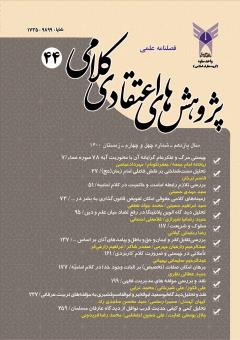بررسی تقابل کفر و ایمان و حق و باطل و پیامدهای آنان بر اساس تشبیهات تمثیلی آیات قرآن
محورهای موضوعی : کلام اسلامیعبدالرحیم زارعیان جهرمی 1 , صفدر شاکر 2 * , ابراهیم زارعیفر 3
1 - دانشجوی دکترای دانشگاه آزاد اسلامی فسا، رشته الهیات، گرایش علوم قرآن و حدیث
2 - استادیار دانشگاه آزاد اسلامی فسا، رشته زبان و ادبیات عرب
3 - استادیار دانشگاه آزاد اسلامی فسا، رشته زبان و ادبیات عرب
کلید واژه: تشبیه تمثیلی, تقابل, حق, باطل, کفر, ایمان,
چکیده مقاله :
از ابزارهای مهمی که می توان به وسیله آن، مفاهیم و مطالب را دقیق تر وسریع تر به أذهان مردم منتقل نمود، استفاده از ضرب المثل، تشبیه، تمثیل و غیره است. قرآن کریم در راستای بیان پیام های هدایتی در قالبی بلاغی و مفهومی، از ابزارهایی همچون استفاده از مثال و تشبیه تمثیلی بهره برده است. در قرآن مجید حدود 500 آیه وجود داردکه دارای تشبیه، تمثیل، کنایه، مجاز و تشبیه تمثیلی می باشد. این مقاله درصدد است با اتخاذ روش توصیفی- تحلیلی، پس از تبیین مفهوم تشبیه تمثیلی و کارکرد قرآنی آن، تشبیهات تمثیلی قرآن کریم در مقوله منافقین و نفاق را مورد بررسی و واکاوی قرار دهد. آنچه مسلم است از ابتدا خلقت حضرت آدم (ع) مبارزه و نبرد حق و باطل برای اثبات توحید و یکتاپرستی و نفی شرک و بتپرستی وجود داشته و تا قیامت نیز وجود خواهد داشت؛ زیرا یکی از مبانی و اصول اوّلیة حق مبارزه با کفر و شرک و باطل است و آیات زیادی در قرآن در همین رابطه نازل شده است. خداوند به همین منظور از تشبیه تمثیلی در قرآن برای تداعی هر چه بیشتر این موضوع به اذهان انسان ها استفاده نموده است. ما نیز در این مطالعه آیاتی در این باب آورده ایم و همچنین در قرآن آیات زیادی درباره مذمت کافران و مشرکان و آنچه می پرستند بیان شده است و تمثیلاتی آورده است و حتی سوره ای کامل به نام سوره کافرون نازل شده است و قرآن برای آن ها تمثیل و تشبیهات زیادی آورده است.
One of the important tools that can be used to convey concepts and content more accurately and quickly to people's minds is the use of proverbs, similes, allegories and so on. The Holy Quran has used tools such as using examples and allegorical similes in order to express guiding messages in a rhetorical and conceptual format. There are about 500 verses in the Holy Quran that have similes, allegories, allusions, metaphors and allegorical similes. This article intends to study and analyze the allegorical similes of the Holy Quran in the category of hypocrites and hypocrisy by adopting a descriptive-analytical method, after explaining the concept of allegorical simile and its Quranic function. What is certain is that from the beginning of the creation of Adam (pbuh) there has been a struggle between right and wrong to prove monotheism, vicariousness and denial of polytheism and apostasy, and there will be resurrection because one of the basic principles of the right is to fight against infidelity, polytheism and falsehood, and many verses in the Qur'an have been revealed in this regard. For this purpose, God has used an allegorical analogy in the Qur'an to associate this issue with human minds as much as possible. We have also included verses in this regard in this chapter of this treatise. Also, in the Qur'an, many verses have been mentioned about the condemnation of the disbelievers and the polytheists and what they worship, and he has given allegories, and even a complete surah called Al-Kafirun surah has been revealed and the Qur'an has given many allegories and similes for them. Although it has been expressed in discussions with various allegories, we have given an example of it here and followed by commentaries by commentators.
قرآن کریم؛ ترجمه ناصر مکارم شیرازی.
قرآن کریم ،ترجمه محمد مهدی فولادوند
ابوحیان اندلسی، محمد بن یوسف، (1420ق)، بیروت: دارالفکر.
ابوالفضل رشیدالدین میبدی،کشف الاسرار
ابوالقاسم محمود زمخشری، تفسیر کشاف، مترجم مسعود انصاری، انتشارات ققنوس، تهران.
ابوالقاسم زمخشری، محمود بن عمر، (1407ق)، الکشاف عن حقائق غوامض التنزیل، بیروت: دارالکتب العربی.
ابن عاشور،التحریروالتنویر، انتشارات دارلفکر، بیروت ،1420.
بيضاوى، عبدالله بن عمر، (1418ق)، أنوار التنزيل و أسرار التأويل،تحقيق: محمد عبد الرحمن المرعشلى، بیروت: دار احياء التراث العربى.
پورنامداریان، تقی، (1388)، سفر در مه، تهران: نگاه.
جرجانی، علی بن محمد، (بی¬تا)، التعریفات، بی¬جا: دارالکتب العلمیۀ.
جلال الدین سیوطی، تفسیر جلالین، ترجمه مسعود قادر مزری ، جلد 5 ، ص 461.
جهان بخش ثواقب، تشبهات و تمثیلات قرآن، چاپ دوم، انتشارات قو، تهران، 1359..
حمزوی، طیبه، مقایسه تشبیه تمثیل در قرآن کریم و نهج¬البلاغه ، دانشگاه پیام نور تهران، 1389.
الخطیب التبریزی، جلال الدین محمد بن عبدالرحمن، (2003م)، الایضاح فی علوم البلاغۀ، بیروت: دارالکتب العلمیۀ.
راغب اصفهانی، حسین بن محمد، (1412ق)، مفردات الفاظ القرآن، بیروتک دارالشامیۀ.
رحیم¬پور، فروغ، تحلیلی از ساختار حق و باطل در قرآن کریم با تأکید بر دیدگاه علامه طباطبایی در المیزان، پژوهش دینی، شماره سیزدهم، تابستان 1385.
سیّد محمدحسین طباطبائی،المیزان، ترجمه ناصر مکارم شیرازی، چاپ ششم،انتشارات امیر کبیر،تهران.
شفیعی کدکنی، محمدرضا، (1366)، صور خیال در شعر فارسی، تهران: آگاه.
عبداللهی، محبوبه، تمثیل روایی و انواع آن در ادب فارسی، پژوهش¬های ادبی و بلاغی، شماره 6، بهار 1393.
عبدالتواب، صلاح¬الدین، (1995م)، الصورۀ الادبیۀ فی القرآن الکریم، بیروت: مکتبۀ اللبنان.
فتوحی، محمود، (1390)، سبک¬شناسی، نظریه¬ها، رویکردها و روش¬ها، تهران: سخن.
طبرسی، فضل بن الحسن، (1375ش)، تفسیر جوامع الجامع، مشهد: آستان قدس رضوی.
طبرسی، فضل بن الحسن، (1372ش) مجمع البیان فی تفسیر القرآن، تهران: فراهانی.
فضل بن حسن طبرسی ،مجمع البیان ، ترجمه حسین نوری همدانی،انتشارات فراهانی،چاپ اوّل
فیض السلام ،نهج البلاغه ،
محسن قرائتی، تفسیر نور، ، انتشارات وزارت فرهنگ و ارشاد اسلامی- چاپ دهم، تهران، بهار 1383.
محمد محمدی ری شهری، میزان الحکمه، انتشارات دارالحدیث قم، 1384 هـ.ش.
محمد بن یوسف،البحرالمحیط، انتشارات دار الفکر،چاپ اوّل،بیروت،1420ه ق.
ناصر مکارم شیرازی، تفسیر نمونه، انتشارات درالکتب الاسلامیه، تهران، 1379ش.
ناصر مکارم شیرازی، مثال¬های زیبای قرآن، انتشارات نسل جوان، چاپ اول قم، سال1386.ه .ش.

